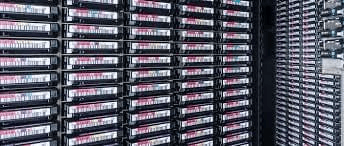A tape drive is a data storage device that reads and writes data on a magnetic tape. Magnetic tape data storage is typically used for offline, archival data storage. Tape media generally has a favourable unit cost and a long archival stability.
A tape Storage provides sequential access storage, unlike a hard disk drive, which provides direct access storage. A disk drive can move to any position on the disk in a few milliseconds, but a tape drive must physically wind tape between reels to read any one particular piece of data. As a result, tape drives have very large average access times. However, tape drives can stream data very quickly off a tape when the required position has been reached. For example, as of 2017 Linear Tape Open (LTO) supports continuous data transfer rates of up to 360 MB/s, a rate comparable to hard disk drives. Magnetic tape drives with capacities less than one megabyte were first used for data storage on mainframe computers in the 1950s.

As of 2018, capacities of 20 terabytes or higher of uncompressed data per cartridge were available. In early computer systems, drives were expensive, but tapes were cheap, so magnetic tape served a s the primary storage medium. Some computer systems ran the operating system on tape drives such as DEC tape. DEC tape has a fixed size indexed block that can be rewritten without disturbing other blocks, allowing you to use DECt ape like a slow drive. Data tape drives can use advanced data integrity techniques such as: B. Multi-level forward error correction, single and linear meandering layout for writing data to tape.
Tape drives can be connected to your computer using SCSI, Fiber Channel, SATA, USB, FireWire, FICON, or other interfaces. Tape drives are used by autoloaders and tape libraries that automatically load, unload, and store multiple tapes. Increase the amount of data that can be stored without manual intervention. In the early days of home computing, floppies and hard drives were very expensive. Many computers are interfaced for storing data via tape recorders and are usually stored in compact cassettes. Simple dedicated tape drives such as professional DECtape for home use, ZX Microdrive and Rotronics Wafadrive are also designed for inexpensive data storage. However, as hard disk drives have fallen in price, these alternatives have been discontinued. Read more…